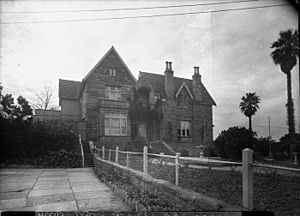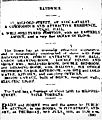Nugal Hall facts for kids
Quick facts for kids Nugal Hall |
|
|---|---|

Nugal Hall in 1951
|
|
| Location | 16-18 Milford Street, Randwick, City of Randwick, New South Wales, Australia |
| Built | 1853 |
| Built for | Alexander McArthur |
| Architect |
|
| Architectural style(s) | Gothic Revival |
| Official name: Nugal Hall | |
| Type | State heritage (complex / group) |
| Designated | 2 April 1999 |
| Reference no. | 173 |
| Type | Mansion |
| Category | Residential buildings (private) |
| Lua error in Module:Location_map at line 420: attempt to index field 'wikibase' (a nil value). | |
Nugal Hall is a historic building in Randwick, a suburb of Sydney, Australia. It was built in 1853 and is known for its beautiful Gothic Revival style. Over the years, it has been a family home, a hospital, and even an embassy. Today, it is a private residence.
The building was designed by two architects: Mortimer Lewis created the eastern part, and Oswald H. Lewis designed the western part. Nugal Hall is so important that it is listed on the New South Wales State Heritage Register, which means it's protected for its historical value.
Contents
History of Randwick
How Randwick Began
The area where Randwick is located today was once part of large land grants. One of the first was given to Captain Francis Marsh in 1824. Later, in 1839, William Newcombe bought land nearby.
Randwick got its name from a town in England called Randwick, Gloucestershire. Two brothers, Simeon and James Pearce, suggested the name. Simeon Pearce came to Australia in 1841 and bought land, naming his property "Randwick." The brothers were very involved in developing Randwick and its nearby suburb, Coogee. Simeon even pushed for a road to be built from Sydney to Coogee, which happened in 1853.
Growing Pains and Progress
In its early days, Randwick was quite isolated. It was surrounded by swamps and sandhills, making travel difficult. A horse-bus service started in the late 1850s, but the journey was often bumpy, with the bus sometimes getting stuck in the sand!
Randwick had different types of people living there. Wealthy families built large, fancy houses. But there were also working-class families who ran market gardens, orchards, and piggeries. Some even lived in simple huts.
In 1858, the NSW Government passed a law allowing suburbs to become official municipalities. Randwick was the first to apply and became a municipality in 1859. This meant it could collect taxes and borrow money to improve the area.
The Racecourse Changes Everything
Randwick was already a place for sports and even illegal activities. In 1860, it had a rough racecourse. But in 1863, John Tait created the Randwick Racecourse, which changed everything. He made horse racing a commercial sport in Australia.
The racecourse brought many improvements to Randwick. Trams replaced the old horse-buses, connecting the suburb to Sydney. Randwick quickly became a busy and successful place. Today, it's still a lively area with homes, businesses, and the University of NSW and Prince of Wales Hospital nearby.
Nugal Hall's Story
Early Days and Design
The land where Nugal Hall stands was originally part of a huge land grant given to Alexander McArthur in 1851. This grant covered a large area of Randwick. Milford Street, where Nugal Hall is located, didn't even exist back then! The original driveway to Nugal Hall came from Avoca Street.
Nugal Hall was designed by Mortimer Lewis, who was the Colonial Architect for New South Wales. He worked on many important buildings between 1830 and 1861. Nugal Hall was one of his last projects. He also designed the Randwick Racecourse and Darlinghurst Courthouse. The stone for Nugal Hall was likely quarried right on the spot, and workers who were on "ticket of leave" (a type of early release from prison) probably helped build it.
The southern part of the house was finished in 1853. It was built for Alexander McArthur, a politician and successful businessman. He came to Sydney from Ireland in 1840. He was a merchant and shipping owner, and he served in the New South Wales Legislative Assembly, which is a part of the government that makes laws.
Famous Residents
Many interesting people have lived at Nugal Hall. One famous resident was Sir John Peden, a well-known lawyer and professor. He was born at Nugal Hall in 1871. His father, Magnus J. Peden, was the Mayor of Randwick and lived there from 1865 to 1872.
Sir John Peden became a professor of law at Sydney University in 1910. He was a very respected legal expert. He also served in the New South Wales Legislative Council, which is another part of the government that helps make laws. He was known for defending free speech and working to improve laws about marriage and workers' rights.
Changes Over Time
The northern part of Nugal Hall was added later, between 1880 and 1903. This section was likely built in the 1880s. It has a curved bay window with a balcony and a unique conical roof. While it matches the Gothic style of the older part, it also includes design elements from the Arts & Crafts and Federation periods, like a circular tower and timber balcony details.
Dr. Fred Tidswell, who owned the Coogee Bay Hotel, completed the northern section. His family lived in Nugal Hall from about 1883 to 1903. It's thought that Oswald H. Lewis, Mortimer Lewis's son, was the architect for this addition.
Other notable residents included Cousins Spencer, who was one of the first people to show films in the Lyceum Theatre. Two Mayors of Randwick and two diplomatic consuls also lived there.
In 1918, Nugal Hall became a Red Cross hospital. It was used as a place for Australian soldiers returning from World War I to recover. The house became a private home again in 1921.
More additions were made to the house in the 1920s and 1930s, especially on its western side. In 1952, Mr. J. R. Pillars, an engineering firm owner, bought the property. His wife, Mrs. Nell Pillars, started the Randwick Historical Society in 1957, and Nugal Hall became its first meeting place.
In 1978, Mr. F. J. Campion bought Nugal Hall. At that time, it had been divided into five separate apartments. He worked to restore it back into a single family home. The house has also faced challenges, including severe damage from hailstorms in 1994 and 2001.
The large grounds of Nugal Hall have been divided over the years. The main entrance is now at the back, while the original front entrance, which faces the ocean, is on the eastern side.
What Nugal Hall Looks Like
Gardens and Views
Nugal Hall sits beautifully within its gardens. Even though the original land has been reduced, the house still has great views. You can see the ocean and the surrounding area from many parts of the house.
The garden has lovely plants, including tall Canary Island date palms along Milford Street and a Californian desert fan palm. There are also sandstone walls and shrubs like hydrangeas.
While new buildings have been constructed nearby, blocking some of the original views, Nugal Hall still offers amazing views of Wedding Cake Island and Coogee Bay. From the ballroom and dining room, you can enjoy the scenery, though some views are now partly hidden by other buildings.
The House Itself
Nugal Hall is a stunning two-story mansion made of sandstone. It's a fantastic example of the Picturesque Gothic Revival style from 1853. It has beautiful decorations, including a magnificent rounded balcony on the upper floor with views of Coogee Bay and the sea.
Inside, the main rooms still look much like they did originally, even with some decorative additions from the 1920s and 1930s. A special feature is the grand stairwell with a beautiful stained glass skylight above it. The stonework, woodwork, and copper turrets are all in good condition. The house also has elegantly shaped windows, fireplaces, and marble columns.
Nugal Hall is very important because it helps preserve the architectural history of Randwick and Coogee, especially as many older buildings in the area have been replaced by modern high-rise developments.
On the western side of the house, there's a single-story addition with brick walls. This part was added in the 1920s or 1930s.
Other Buildings
Next to Nugal Hall on Milford Street is a former carriage house. This building was originally used for horse-drawn vehicles. It has since been changed into a residence. There is also a 20th-century garage located north of the former carriage house.
Nugal Hall's Heritage Status
Nugal Hall is very important to the history of New South Wales. It's a great example of a large stone mansion built in the Gothic Revival style by the Colonial Architect, Mortimer Lewis, in 1853. The land was first granted to Alexander McArthur in 1851.
Even though it's not as grand as some other Gothic Revival houses in Sydney, Nugal Hall is still very impressive. It's connected to many important people from the past. It's especially significant in Randwick and Coogee, where new tall buildings have replaced much of the area's older architecture. Nugal Hall stands out and is visually important in the local area.
Nugal Hall was officially listed on the New South Wales State Heritage Register on 2 April 1999, recognizing its special historical value.
Images for kids

















